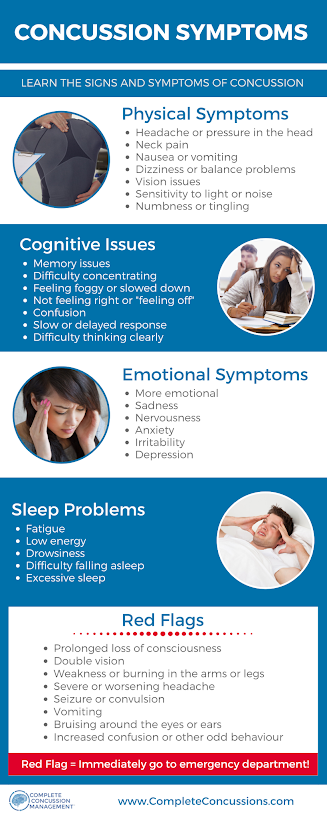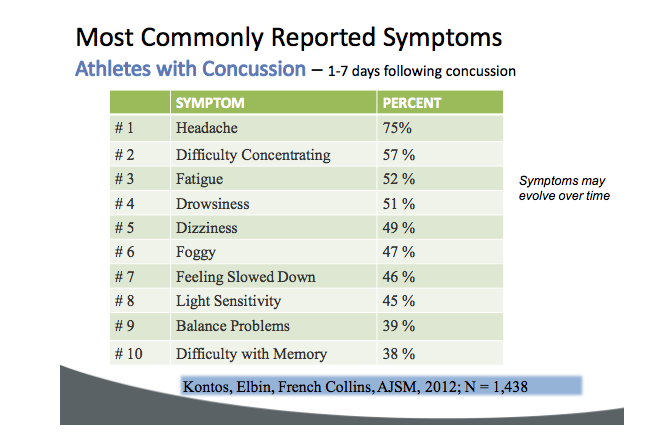Concussions, Part 2: What Should I Look For?
Aug 16, 2018Last week, we dove head first into concussions (sorry, I can’t help it), looking at what exactly defines a concussion and what sports populations are most at risk. If you missed it, check out Concussions, Part 1.
The interesting part about concussions is that you may not see some signs or symptoms present until minutes, hours, or even days later, which is why I want to equip you with the knowledge to know what to look for in part 2 of this Concussion series.
The easiest way to do this is to break it down into acute (sudden/very recent concussion) and chronic (prolonged period of time after concussion) phases.
Acute:
But first, a story about Billy Bob.
So say it’s 3rd and goal with 10 seconds left in the 4th quarter. Your high school team is losing 22-27. This game decides whether your team goes to the state championship. The ball snaps and Billy Bob, the running back, runs towards the goal. He is instantly met by the middle linebacker with a head-to-head collision. Now, it’s 4th down. Billy Bob lays there and struggles to get up. The team Athletic Trainer (AT) runs on the field and finds that he is able to now stand up, but definitely notices something is off. Billy Bob repeatedly assures the AT that he is okay and can play the final play.
What do you do as the AT? As the head coach? As the parent? – do you sit Billy Bob out? What about the game?
This seems like a no-brainer (again, sorry), but can be a very controversial call, especially when there’s a game on the line.
I always go by the rule: “When in doubt, sit it out.”
Now, you’re probably saying, “Ravi, quit being a softy and suck it up. There’s a game to win!” But as someone who has personally experienced a concussion, I would say the risk is not worth the reward. Let me explain why…
Introducing Second Impact Syndrome (SIS) – This happens when an initial concussion has occurred or not fully resolved and the individual receives another concussion, this time resulting in more severe complications including excessive swelling in the brain. That’s no bueno.
If I have you freaked out, don’t worry. This is a rare occurrence, but it can happen. As long as everyone is doing their job, there should be nothing to worry about.
And, statistically speaking, most concussions resolve within a matter of 7-10 days.
“Can imaging diagnose a concussion?” No. This is a HUGE misconception. Currently, there is no imaging that can effectively diagnose a concussion. Typically, most concussions present as a functional issue, rather than a true structural issue (Think more of how a computer program runs rather than the wires connecting it) which is why imaging is rarely helpful.
Signs and Symptoms of a Concussion:


Each concussion can present with different signs and symptoms based on numerous factors (i.e. where the impact was, number of concussions, severity, etc.), which is why every concussion must be evaluated and treated on a case-by-case basis. As you can see above, headache takes the cake for most common symptom. Recognizing these signs and symptoms can be very helpful to make sure no concussion goes undiagnosed.
Chronic:
Introducing Post-Concussion Syndrome (PCS) – this is categorized as a complex disorder in which symptoms – such as headaches and dizziness – continue to persist for more than 21-28 days after the initial injury.
A variety of factors can play into why there are prolonged symptoms:
- Severity and number of concussions
- Cervical spine (neck) function
- Vision or vestibular (balance) systems
- Psychosocial factors
- Blood flow
A team approach is most effective to tackle these acute and chronic concussion cases by utilizing a variety of treatment approaches.
Next week, we’ll discuss the final part of this series where we’ll cover management and return to play for concussions. In the meantime, if you have any questions, please feel free to reach out by giving us a call at 470-355-2106 or clicking the button below!
Cheers,
Dr. Ravi, PT, DPT, CSCS
Let us help you figure out to live your best active life today!
Remember, Movement is Medicine!

